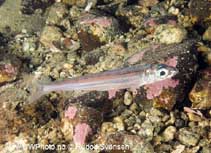Upload your photos and videos
Pictures | Google imageArgentina silus
Picture by Svensen, R.
Pictures | Google imageArgentina silus
Picture by Svensen, R.
Norway country information
Common names:
Gull-laks, Vassild
Occurrence: native
Salinity: marine
Abundance: | Ref:
Importance: | Ref:
Aquaculture: | Ref:
Regulations: | Ref:
Uses: no uses
Comments: Known from Skagerrak to Finnmark (Ref. 40562).
National Checklist:
Country Information: https://www.cia.gov/library/publications/resources/the-world-factbook/geos/no.html
National Fisheries Authority: http://odin.dep.no/fid/eng/
Occurrences: Occurrences Point map
Main Ref: Muus, B. and P. Dahlström, 1978
National Database:
Occurrence: native
Salinity: marine
Abundance: | Ref:
Importance: | Ref:
Aquaculture: | Ref:
Regulations: | Ref:
Uses: no uses
Comments: Known from Skagerrak to Finnmark (Ref. 40562).
National Checklist:
Country Information: https://www.cia.gov/library/publications/resources/the-world-factbook/geos/no.html
National Fisheries Authority: http://odin.dep.no/fid/eng/
Occurrences: Occurrences Point map
Main Ref: Muus, B. and P. Dahlström, 1978
National Database:
Common names from other countries
Classification / Names Nomi Comuni | Sinonimi | Catalog of Fishes(Genere, Specie) | ITIS | CoL | WoRMS | Cloffa
> Argentiniformes (Marine smelts) > Argentinidae (Argentines or herring smelts)
Etymology: Argentina: Latin, argentus = silver (Ref. 45335).
Etymology: Argentina: Latin, argentus = silver (Ref. 45335).
Environment: milieu / climate zone / depth range / distribution range Ecologia
marino batipelagico; oceanodromo (Ref. 51243); distribuzione batimetrica 55 - 1440 m (Ref. 117245), usually 55 - 550 m (Ref. 117245). Deep-water; 80°N - 42°N, 71°W - 31°E
Distribuzione Stati | Aree FAO | Ecosystems | Presenze | Point map | Introduzioni | Faunafri
Eastern Atlantic: Svalbard to west coasts of Scotland and Ireland, deeper parts of North Sea and across the Wyville Thomson ridge to Denmark Strait. Western Atlantic: Davis Strait to George's Bank in Canada. Arctic Ocean: east to Finnmark, Norway, Barents Sea (Ref. 86838).
Length at first maturity / Size / Peso / Age
Maturity: Lm 26.0 range ? - ? cm
Max length : 70.0 cm SL maschio/sesso non determinato; (Ref. 35388); Età massima riportata: 35 anni (Ref. 35388)
Max length : 70.0 cm SL maschio/sesso non determinato; (Ref. 35388); Età massima riportata: 35 anni (Ref. 35388)
Short description Chiavi di identificazione | Morfologia | Morfometria
Raggi dorsali molli (totale) : 11 - 13; Raggi anali molli: 11 - 17. Scales with tiny spines on exposed parts. Dorsal fin begins above or nearly above tip of pectoral fin (Ref. 7251). Swim bladder elongated and silvery. Body slender to robust (Ref. 37473).
Bathypelagic (Ref. 58426). Prefer depths of 182.8-255.9 m, temperature 7-10°C and mean salinity 34 ppt (Ref. 5951). Probably form schools close to the bottom. Feeds on planktonic invertebrates including euphausiids, amphipods (arrow worms, krill and Thermisto (Ref. 5951)), chaetognaths, squids and ctenophores, also small fishes. Spawns from April to July (Ref. 4773). Growth is slow. Eggs and young are pelagic at depths of 400-500m. Used fresh or in fish meal production (Ref. 35388).
Life cycle and mating behavior Maturità | Riproduzione | Deposizione | Uova | Fecundity | Larve
Main reference
Upload your references | Bibliografia | Coordinatore | Collaboratori
Cohen, D.M., 1984. Argentinidae (including Microstomatidae). p. 386-391. In P.J.P. Whitehead, M.-L. Bauchot, J.-C. Hureau, J. Nielsen and E. Tortonese (eds.) Fishes of the north-eastern Atlantic and the Mediterranean, Volume 1. Unesco, Paris. (Ref. 4773)
Threat to humans
Harmless
Human uses
Pesca: commerciale
FAO(pesca: production; publication : search) | FIRMS (Stock assessments) | FishSource | Sea Around Us
Informazioni ulteriori
Population dynamics
Growth parameters
Max. ages / sizes
Length-weight rel.
Length-length rel.
Length-frequencies
Mass conversion
Reclutamento
Abbondanza
Growth parameters
Max. ages / sizes
Length-weight rel.
Length-length rel.
Length-frequencies
Mass conversion
Reclutamento
Abbondanza
Life cycle
Riproduzione
Maturità
Fecundity
Deposizione
Spawning aggregations
Uova
Egg development
Larve
Dinamica popolazioni larvali
Riproduzione
Maturità
Fecundity
Deposizione
Spawning aggregations
Uova
Egg development
Larve
Dinamica popolazioni larvali
Physiology
Body composition
Nutrients
Oxygen consumption
Swimming type
Swimming speed
Visual pigments
Fish sound
Diseases & Parasites
Toxicity (LC50s)
Body composition
Nutrients
Oxygen consumption
Swimming type
Swimming speed
Visual pigments
Fish sound
Diseases & Parasites
Toxicity (LC50s)
Human related
Aquaculture systems
Profili di acquacoltura
Varietà
Ciguatera cases
Stamps, coins, misc.
Aquaculture systems
Profili di acquacoltura
Varietà
Ciguatera cases
Stamps, coins, misc.
Strumenti
E-book | Giuda pratica | Chiavi di identificazione | Generatore frequenze di lunghezza | Strumento Parametri Biologici | Mappa dei ritrovamenti | Classification Tree
| Catch-MSY |
Special reports
Download XML
Fonti Internet
Aquatic Commons | BHL | Cloffa | Websites from users | Check FishWatcher | CISTI | Catalog of Fishes(Genere, Specie) | DiscoverLife | ECOTOX | Faunafri | Fishtrace | GenBank(genome, nucleotide) | GloBI | GOBASE | | Google Books | Google Scholar | Google | IGFA World Record | MitoFish | Database Nazionali | Otolith Atlas of Taiwan Fishes | PubMed | Reef Life Survey | Scirus | SeaLifeBase | Tree of Life | Wikipedia(Go, ricerca) | World Records Freshwater Fishing | Zoological Record
Estimates based on models
Preferred temperature (Ref. 115969): 1.4 - 10.2, mean 5.5 (based on 587 cells).
Phylogenetic diversity index (Ref. 82804): PD50 = 0.5001 [Uniqueness, from 0.5 = low to 2.0 = high].
Bayesian length-weight: a=0.00355 (0.00202 - 0.00624), b=3.20 (3.05 - 3.35), in cm Total Length, based on LWR estimates for this species & (Sub)family-body (Ref. 93245).
Trophic level (Ref. 69278): 3.3 ±0.3 se; based on diet studies.
Resilienza (Ref. 120179): Basso, tempo minimo di raddoppiamento della popolazione 4.5 - 14 anni (K=0.12-0.14; tm=5-9).
Prior r = 0.34, 95% CL = 0.23 - 0.51, Based on 7 full stock assessments.
Fishing Vulnerability (Ref. 59153): High to very high vulnerability (66 of 100).
Climate Vulnerability (Ref. 125649): Moderate to high vulnerability (47 of 100).




